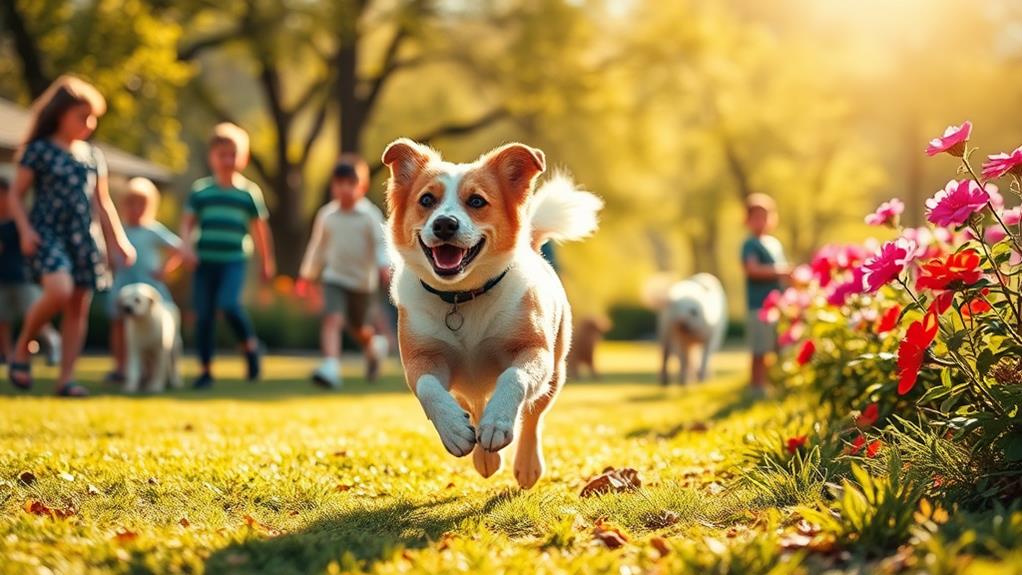You can harness your dog's confidence by fostering positive interactions. Start by socializing them in various environments to reduce anxiety and fear. Use positive reinforcement, like treats and praise, to reward their good behavior consistently. Gradually expose them to new experiences, allowing them to acclimate at their own pace. Building trust with other dogs and engaging with people through calm, rewarding encounters makes a big difference. Don't forget to recognize their body language and celebrate small achievements to boost their self-esteem. There's so much more you can do to help your furry friend gain confidence and thrive.
Understanding Canine Confidence
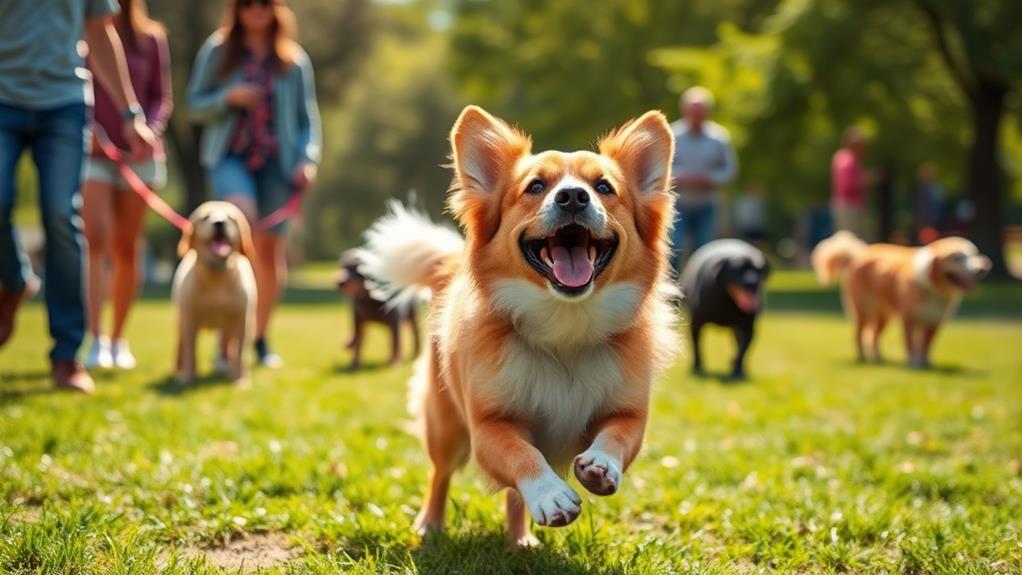
Understanding your dog's confidence is pivotal for fostering a strong bond and ensuring their well-being. Canine confidence manifests in various ways, from how your dog interacts with their environment to their reactions during daily activities. Observing your dog's body language can provide valuable insights. When your dog feels secure, they may stand tall, wag their tail, and approach new experiences with curiosity.
On the other hand, a lack of confidence might show through cowering, excessive barking, or avoidance behavior. These signs indicate that your dog might be feeling anxious or unsure in certain situations. It's indispensable to recognize these behaviors early on, as they can impact your dog's overall happiness and ability to cope with new experiences.
To help build your dog's confidence, create an environment where they feel safe and supported. Encourage them through positive reinforcement, offering treats and praise when they display brave behavior. Gradually introduce them to new experiences at their own pace, ensuring they don't feel overwhelmed. By understanding your dog's confidence, you can nurture their self-esteem and promote a more relaxed, happy, and well-adjusted companion.
The Importance of Socialization
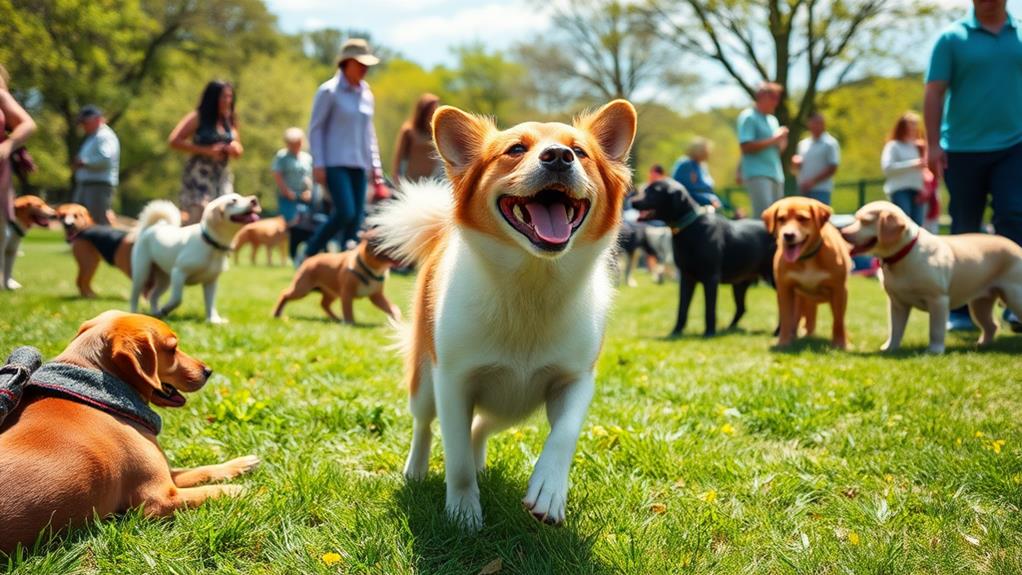
Socialization plays a significant role in building your dog's confidence and overall happiness. When you expose your dog to various environments, people, and other animals, you help them learn how to navigate the world around them. This exposure reduces anxiety and fear, making your dog feel more secure and at ease.
Start by introducing your dog to different sounds, sights, and smells in a controlled manner. Take them on walks in busy areas or visit dog parks where they can interact with other dogs. Gradually increase the level of stimulation to prevent overwhelming them.
It's essential to pay attention to your dog's body language during these interactions. If they seem stressed, take a step back and allow them to acclimate at their own pace. Encouraging positive experiences during socialization will build their confidence over time.
Positive Reinforcement Techniques
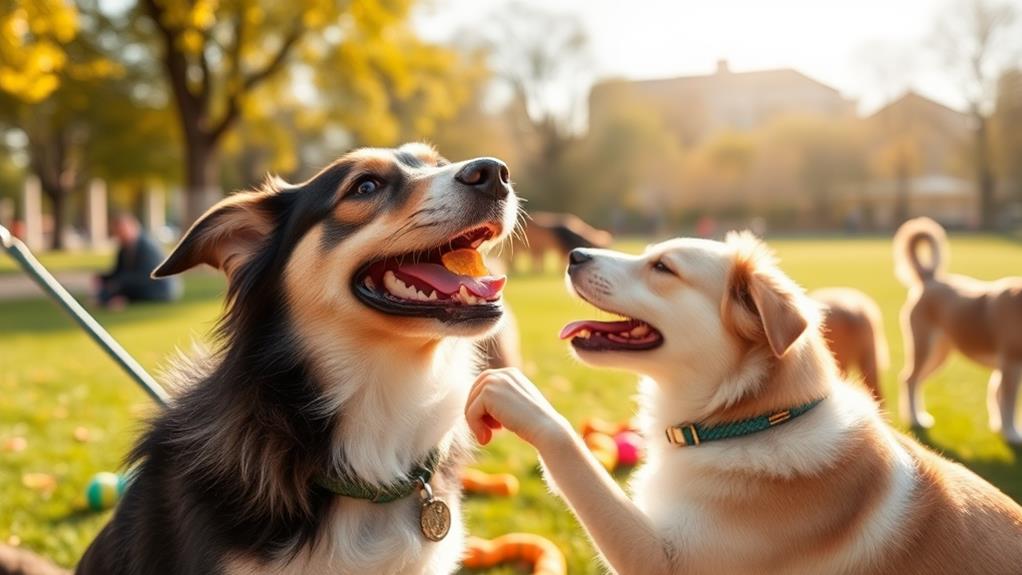
Positive reinforcement is a powerful tool that can greatly boost your dog's confidence. By rewarding desired behaviors with treats, praise, or playtime, you create a positive association in your dog's mind. Start by identifying what motivates your pup, whether it's a favorite toy, tasty treats, or verbal praise.
When your dog performs a behavior you like, such as sitting on command or greeting new people calmly, immediately reward them. This reinforces the idea that good things happen when they behave positively. Consistency is key, so make sure you reward them every time they display the behavior you want, especially in the beginning.
As your dog begins to understand what earns them rewards, you can gradually start to vary the rewards. Mix treats with verbal praise or playtime to keep things exciting. Remember to be patient; building confidence takes time.
Avoid punishing your dog for mistakes, as this can lead to fear and anxiety. Instead, redirect their attention to a more desirable behavior and reward that. By focusing on positive reinforcement techniques, you're not only teaching your dog but also helping them feel secure and confident in their environment.
Gradual Exposure to New Environments
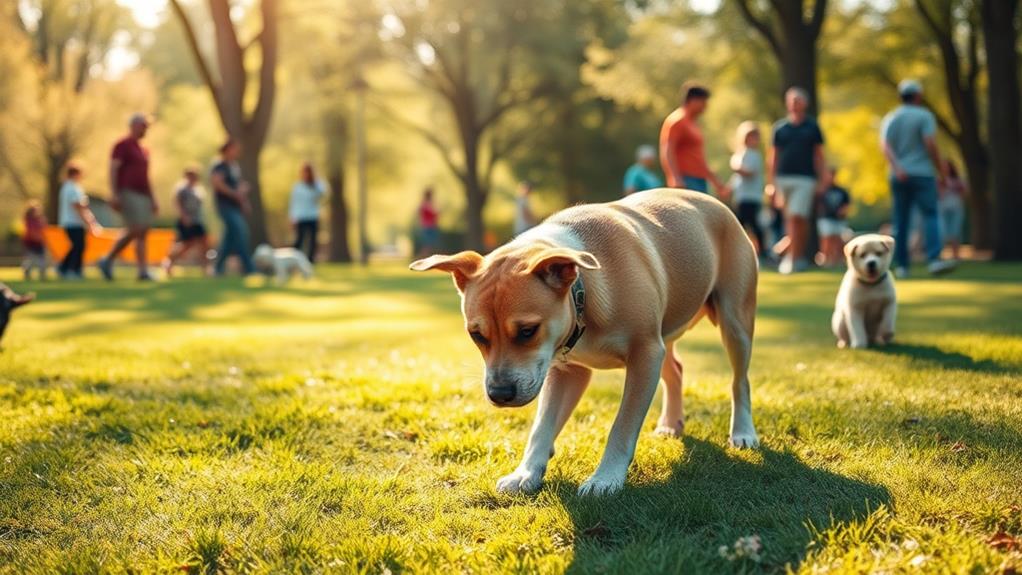
Helping your dog build confidence doesn't stop with positive reinforcement; it also involves gradually exposing them to new environments. Start by taking short trips to places your dog hasn't been before, like a local park or a friend's backyard. Keep these outings brief and positive, allowing your dog to explore without feeling overwhelmed.
As you introduce new settings, observe your dog's body language. If they seem anxious or scared, take a step back. Allow them time to acclimate before moving forward. You might even bring along some favorite toys or treats to create a sense of familiarity.
Once your dog seems comfortable in one environment, gradually increase the complexity of the outings. This could mean visiting busier parks or areas with more distractions. Always guarantee their positive experiences with praise and treats.
Building Trust With Other Dogs
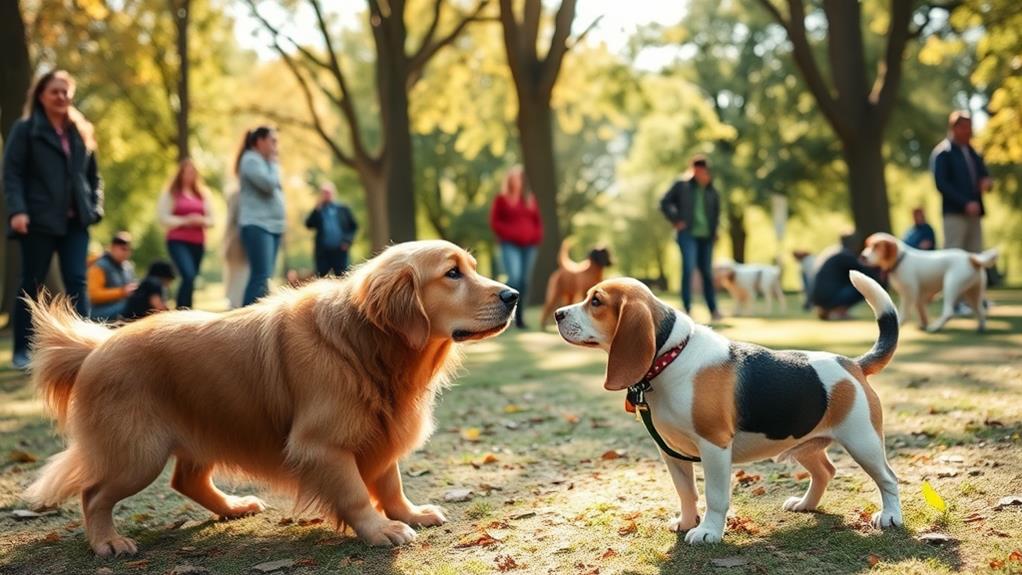
Building trust with other dogs is essential for your pup's confidence and social skills. When dogs feel secure around their peers, they're more likely to engage positively. Here are some key steps to foster that trust:
| Approach | Benefits |
|---|---|
| Gradual Introductions | Reduces anxiety and fear |
| Positive Reinforcement | Encourages friendly interactions |
| Supervised Play Sessions | Guarantees safety and builds confidence |
| Socialization Classes | Provides structured environments for learning |
Start by introducing your dog to other friendly dogs in a controlled environment. Choose calm, well-socialized dogs that can help set a positive example. Use treats to reward your pup for calm behavior during interactions.
Always keep an eye on body language—yours and theirs. Look for signs of stress or discomfort, and don't force interactions. If your dog seems overwhelmed, take a step back and allow them to observe from a distance.
Over time, these positive experiences will help your dog build trust with other dogs, enhancing their confidence and encouraging healthier social skills.
Engaging With People Effectively
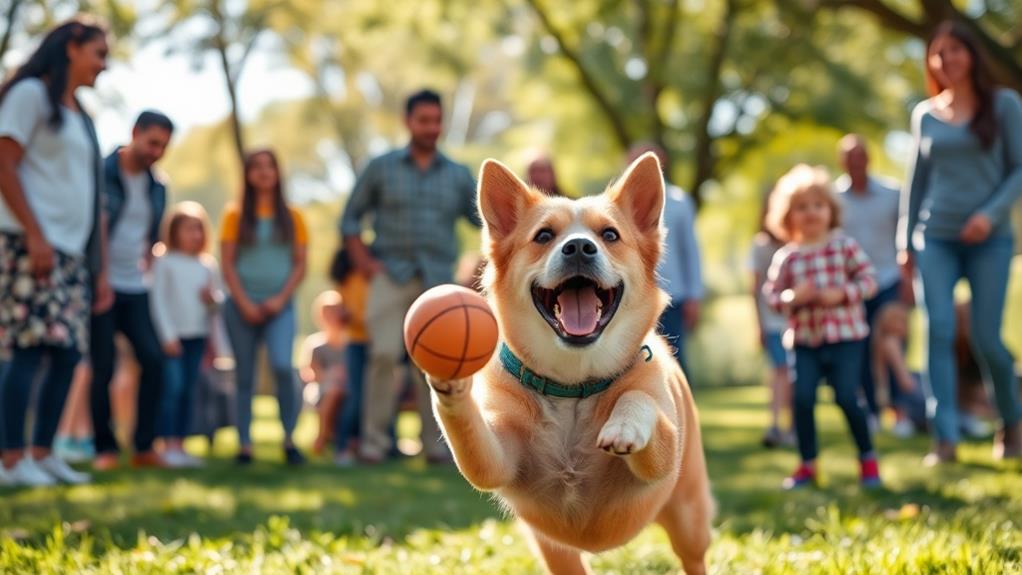
Engaging effectively with people is pivotal for your dog's overall confidence and social development. When you introduce your dog to new people, approach the situation with a calm demeanor. Your energy influences your dog's reactions. If you're relaxed, your dog is more likely to feel secure.
Encourage positive interactions by having people kneel or sit at your dog's level. This makes your dog feel less threatened and more willing to approach. Always ask permission before allowing anyone to touch your dog. This sets a positive tone for the interaction and helps your dog feel respected.
Use treats or toys to reward your dog during these encounters. It'll create positive associations with new people, reinforcing the idea that engaging with them is a good thing. Be patient and give your dog time to acclimate. If your dog seems unsure or anxious, don't force the interaction; instead, back off and try again later.
Regular practice is key. The more your dog interacts with diverse individuals, the more confident they'll become. Celebrate small victories and stay consistent, and you'll notice your dog's confidence in engaging with people improve over time.
Creating Safe Play Experiences
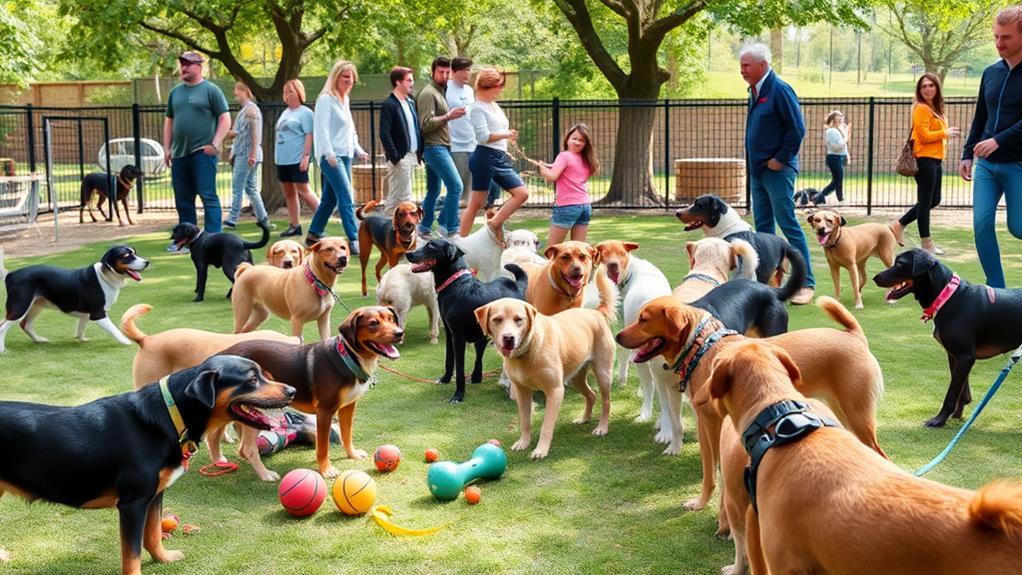
Creating safe play experiences is just as important as positive interactions with people when it comes to boosting your dog's confidence. You want to guarantee your dog feels secure and relaxed during playtime, as this is when they can truly thrive.
Start by choosing an appropriate environment—look for spaces that are free from distractions and potential hazards. Familiar locations, like your backyard or a dog park during off-peak hours, can be great options.
Next, consider your dog's playmates. Whether you're inviting other dogs or engaging in solo play, select companions who are friendly and well-socialized. Monitor interactions closely to prevent overwhelming situations. If your dog seems hesitant or anxious, give them the space they need to acclimate.
Incorporate a variety of toys and activities to keep play engaging and fun. Rotate toys regularly to maintain interest and prevent boredom. Always supervise play sessions, stepping in if things get too rough or if your dog appears uncomfortable.
Recognizing Body Language Signals
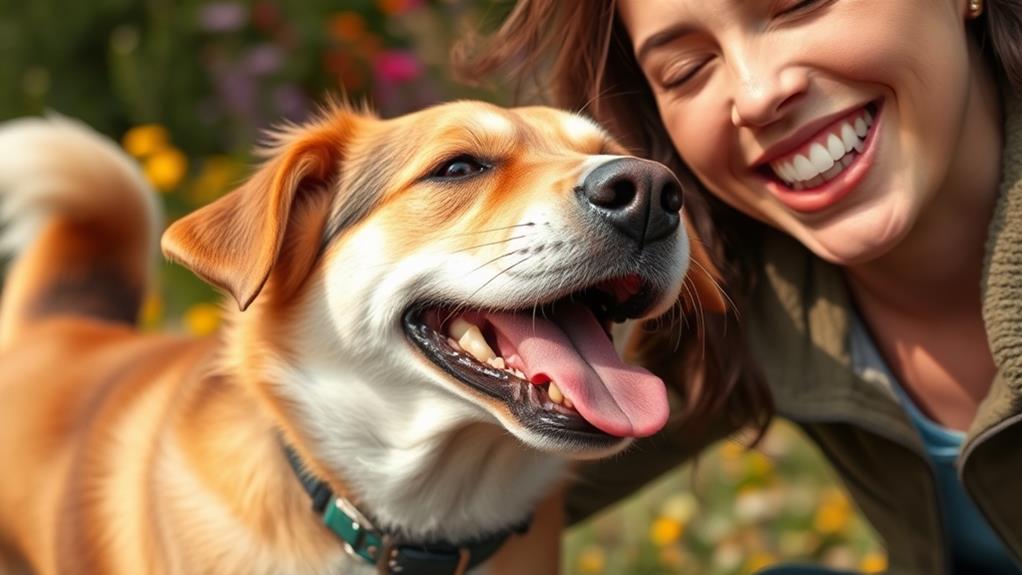
Understanding your dog's body language is essential for fostering positive interactions and enhancing their confidence. By paying attention to their signals, you can better respond to their needs and feelings. For instance, if your dog has a relaxed posture, with a wagging tail and soft eyes, they're likely feeling happy and comfortable.
On the other hand, a stiff body, raised hackles, or a tucked tail could indicate fear or anxiety. When you see these signs, it's important to assess the situation and provide reassurance. If your dog avoids eye contact or turns away, they might be feeling overwhelmed. In these cases, giving them space can help them regain their composure.
Also, notice any vocalizations. A low growl can signal discomfort, while playful barks often indicate excitement. By recognizing these cues, you can create a safe environment that encourages your dog to express themselves freely.
Ultimately, being attuned to your dog's body language allows you to build trust, which is pivotal for their confidence. The more you understand their signals, the better you can support them in various situations, leading to stronger bonds and happier experiences together.
Celebrating Small Achievements
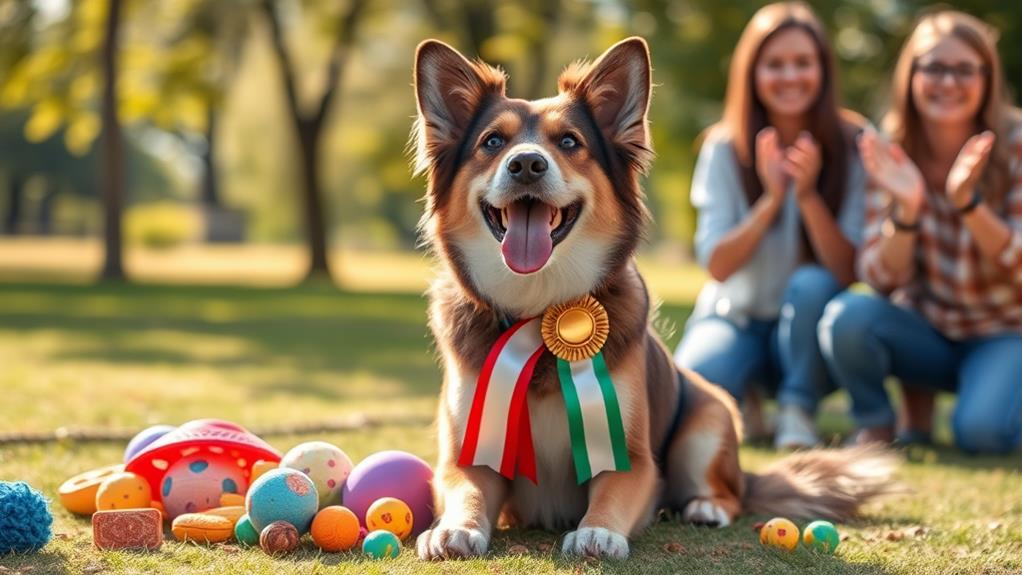
Recognizing your dog's body language sets the stage for building their confidence, and one effective way to reinforce this is by celebrating small achievements. When your pup accomplishes something, no matter how minor it may seem, take a moment to acknowledge it. This could be as simple as sitting on command, approaching a new person, or even just exploring a new environment. Each of these actions deserves recognition.
You can celebrate these wins with enthusiastic praise, treats, or a quick game of fetch. Your excitement will help your dog associate these small achievements with positive experiences. Remember, consistency is key. Celebrate every success, and you'll create an environment where your dog feels valued and confident.
Additionally, keep track of these milestones. Create a journal or a chart to note your dog's progress. Visual reminders of their achievements can boost their confidence even further. By focusing on their growth rather than perfection, you foster a supportive atmosphere that encourages your dog to take risks.
With time and patience, celebrating small achievements will lead to significant improvements in your dog's confidence and overall behavior. So, go ahead—cheer them on!
Frequently Asked Questions
Can I Use Treats for All Positive Reinforcement Methods?
Yes, you can use treats for positive reinforcement methods, but variety helps too. Incorporate praise, toys, or playtime to keep your dog engaged. Mix things up to find what motivates your pup best!
How Long Does It Take to Build My Dog's Confidence?
Building your dog's confidence can take weeks to months, depending on their personality and past experiences. Consistent positive reinforcement and patience create a safe environment, helping your pup feel secure and grow more confident over time.
Are Certain Dog Breeds More Confident Than Others?
Research shows that breeds like German Shepherds and Golden Retrievers often score higher in confidence tests. However, individual personality matters too; your dog's environment and experiences can powerfully influence their overall confidence level.
What Should I Do if My Dog Is Fearful Around Strangers?
If your dog's fearful around strangers, start by introducing them slowly. Use treats and positive reinforcement to create a happy association. Keep encounters short and calm, gradually increasing exposure as your dog grows more comfortable.
Can I Practice These Techniques With an Older Dog?
Imagine your older dog wagging its tail, feeling safe and secure. You can practice these techniques, adapting them to their pace, building trust, and watching their confidence bloom as you nurture their spirit together.
Conclusion
By nurturing your dog's confidence through positive interactions, you're crafting a sturdy bridge that connects them to the world around them. Each encounter, whether with other dogs or people, adds another plank to that bridge, making it stronger and more resilient. Remember, patience is key; celebrate those small achievements along the way. With your guidance, your dog will blossom into a confident companion, ready to explore life's adventures with you by their side.

